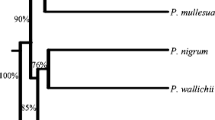Abstract
Randomly amplified polymorphic DNA (RAPD) markers were used for the identification of pigeonpea [Cajanus cajan (L.) Millsp.] cultivars and their related wild species. The use of single primers of arbitrary nucleotide sequence resulted in the selective amplification of DNA fragments that were unique to individual accessions. The level of polymorphism among the wild species was extremely high, while little polymorphism was detected within Cajanus cajan accessions. All of the cultivars and wild species under study could be easily distinguished with the help of different primers, thereby indicating the immense potential of RAPD in the genetic fingerprinting of pigeonpea. On the basis of our data the genetic relationship between pigeonpea cultivars and its wild species could be established.
Similar content being viewed by others
References
Deodikar GB, Thakar CV (1956) Cyto-taxonomic evidence for the affinity between cajanus indicus spreng and certain erect species of Atyeosia. W. and A. Proc Indian Acad Sci Sect B 43:37–45
Dundas IS (1984) Cytogenetic investigations involving pigeonpea [Cajanus cajan (L.) Millsp.] and some Australian Atyeosia species. PhD thesis, Department of Agriculture, University of Queensland, Australia
Gupta SC, Reddy LJ, Sharma D, Green JM, Murthi AN, Saxena KD (1980) Maintenance of pigeonpea cultivars. In: Nene YL (eds) Proc Int Workshop Pigeonpea, vol 2. ICRISAT, Patancheru, A.P., India, pp 295–301
Jain A, Bhatia S, Banga SS, Prakash S, Lakshmikumaran M (1994) Potential use of random amplified polymorphic DNA (RAPD) technique to study the genetic diversity in Indian mustard (Brassica juncea) and its relationship to heterosis. Theor Appl Genet 88:116–122
Joshi CP, Nguyen HT (1993) RAPD (random amplified polymorphic DNA) analysis based intervarietal genetic relationships among hexaploid wheats. Plant Sci 93:95–103
Kollipara KP, Singh L, Hymowitz T (1994) Genetic variation of trypsin and chymotrypsin inhibitors in pigeonpea [Cajanus cajan (L.) Millsp.] & its wild relatives. Theor Appl Genet 8:986–993
Kumar LS, Thombre MV, D'Cruz R (1958) Cytological studies of an intergeneric hybrid of Cajanus cajan (L.) Millsp. and Atylosia lineata W. and A. Proc Indian Acad Sci Sect B 47:252–262
Ladizinsky G, Hamel H (1980) Seed protein profiles of pigeonpea (Cajanuscajan)and some Atylosia species. Euphytica 29:313–317
Nadimpalli BG, Jarret RL, Pathak SC, Kochert G (1992) Phylogenetic relationships of the pigeonpea (Cajanus cajan) based on nuclear restriction fragment length polymorphisms. Genome 36:216–223
Nei M, Li WH (1979) Mathematical model for studying genetic variation in terms of restriction endonucleases. Proc Natl Acad Sci USA 76:5269–5273
Paran I, Kesseli RV, Michelmore RW (1991) Identification of restriction fragment length polymorphism and randomly amplified polymorphic DNA markers linked to downy mildew resistance genes in lettuce, using near isogenic lines. Genome 34:1021–1027
Pundir RPS, Singh RB (1985a) Biosystematic relationships among Cajanus, Atylosia and Rhynchosia species and evolution of pigeonpea [Cajanus cajan (L.) Millsp.] Theor Appl Genet 69:531–534
Pundir RPS, Singh RB (1985b) Crossability relationships among Cajanus, Atylosia, and Rhynchosia species and detection of crossing barriers. Euphytica 34:303–308
Rafalski JA, Tingey SV, Williams JGK (1991) RAPD markers — a new technology for genetic mapping and plant breeding. Agbiotech News Info 3:645–648
Reddy LJ, Green JM, Sharma D (1980) Genetics of Cajanus cajan (L.) Millsp. x Atylosia spp. In: Nene YL (eds) Proc Int Workshop Pigeonpea, vol 2. ICRISAT, Patancheru, A.P., India, pp 39–50
Remanandan P (1980) The wild gene pool of Cajanus at ICRISAT. Present and future. In: InNene YL (eds) Proc. Int. Workshop Pigeonpea, vol 2. ICRISAT, Patancheru, A.P., India, pp 29–38
Remanandan P (1990) Pigeonpea: genetic resources In: Nene YL, Hall SD, Sheila VK (eds) The Pigeonpea. CAB Int, ICRISAT, India pp 89–115
Rogers SO, Bendich AJ (1988) Extraction of DNA from plant tissues. In: Gelvin SB, Schilperoort RA (eds). Plant molecular biology manual, A6: 1. Kluwer Academic Publ, Dordrecht, The Netherlands
Sen SK, Sur SC (1964) A study on vicinism in pigeonpea [Cajanus cajan (L.) Millsp.]. Agricultura 12:421–426
Shrivastava MP, Singh L, Singh RP (1976) Heterosis in pigeonpea. Indian J Genet Plant Breed 36:197–200
Singh U, Jambunathan R (1981) Protease inhibitors and in-vitro protein digestibility of pigeonpea [Cajanus cajan (L.) Millsp.] and its wild relatives. J Food Sci Technol 18:246–247
Van der Maesen LJG (1986) Cajanus DC and Atylosia W. & A. (Leguminoseae). Agricultural University Wageningen Papers 85–94 (1985). Agricultural University, Wageningen, The Netherlands
Williams CE, Clair DAS (1993) Phenetic relationships and levels of variability detected by restriction fragment length polymorphism and random amplified polymorphic DNA analysis of cultivated and wild accessions of Lycopersicon esculentum. Genome 36:619–630
Williams JGK, Kubelik AR, Livak KJ, Rafalaski JA, Tingey SV (1990) DNA polymorphism amplified by arbitrary primers are useful as genetic markers. Nucleic Acids Res 13:6531–6533
Williamson VM, Ho JY, Wu FF, Miller N, Kaloshian I (1994) A PCR-based marker tightly linked to the nematode resistance gene, Mi, in tomato. Theor Appl Genet 87:757–763
Yadavendra JP (1986) Use of wild relatives in pigeonpea improvement, In: Tikka SBS (ed) Pigeonpea genetics and improvement, Sharda Publ Academy, India, pp 75–87
Author information
Authors and Affiliations
Additional information
Communicated by P. M. A. Tigerstedt
NCL Communication No. 6062
Rights and permissions
About this article
Cite this article
Ratnaparkhe, M.B., Gupta, V.S., Ven Murthy, M.R. et al. Genetic fingerprinting of pigeonpea [Cajanus cajan (L.) Millsp.] and its wild relatives using RAPD markers. Theoret. Appl. Genetics 91, 893–898 (1995). https://doi.org/10.1007/BF00223897
Received:
Accepted:
Issue Date:
DOI: https://doi.org/10.1007/BF00223897




